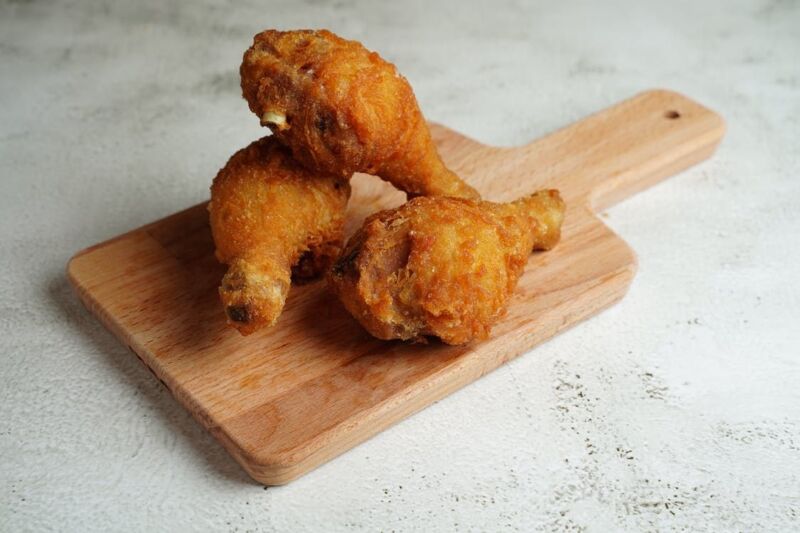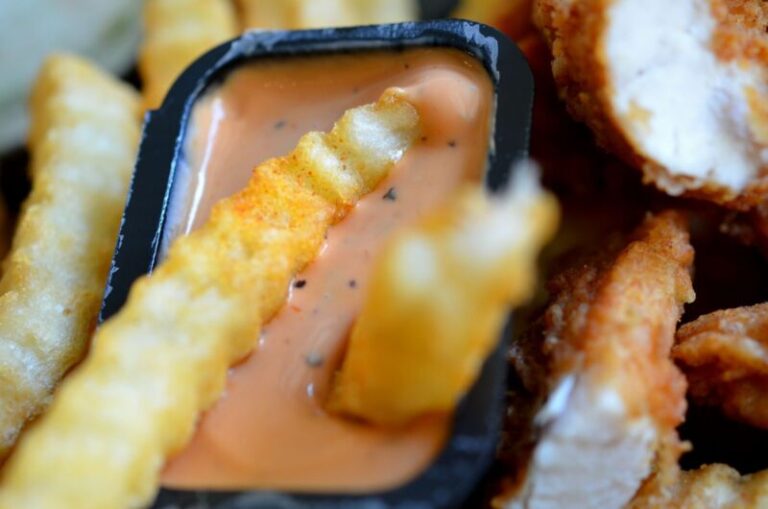How Long To Deep Fry Chicken Legs? (+Recipes)
Fried chicken is a beloved comfort food enjoyed by people across the globe. From Korean fried chicken to American Southern fried chicken, there are countless ways to prepare this crispy, juicy dish. Deep frying is one of the most popular cooking methods for chicken legs, yielding an irresistible crunchy exterior and tender, flavorful meat when done right. But how long should you deep fry chicken legs to achieve the perfect balance of textures?
In this article, we will cover everything you need to know about deep frying chicken legs, from ideal cooking times to step-by-step recipes and storage tips. Read on for foolproof techniques to make succulent, golden brown deep fried chicken legs at home.
Factors That Affect Chicken Leg Fry Times
There are several variables that impact how long to fry chicken legs, including:
Size of the Chicken Legs
Larger chicken legs naturally take longer to cook through than smaller ones. Jumbo legs may need 12-15 minutes in the hot oil, while average sized legs require 10-12 minutes. Always take into account the thickness and overall size of the legs when estimating fry times.
Oil Temperature
The temperature of the oil plays a key role in cooking times. Ideally, the oil should be between 350-375°F to properly fry chicken legs. Hotter oil will cook the legs faster, while cooler oil will extend the cooking time. Invest in a deep fry thermometer and preheat your oil properly.
Desired Doneness
Do you prefer your chicken legs lightly golden or deep golden brown? Leaving them in the fryer for a few minutes extra will result in a darker, crunchier crust. Decide your ideal finished texture and color to determine the best fry time.
Quantity of Chicken Legs
Frying a few chicken legs at a time enables even cooking. Overcrowding the pot will lower the oil temperature and prevent the legs from browning properly. For food safety, work in batches to allow the oil to regain heat between frying.
Recommended Time to Fry Chicken Legs

Taking these factors into account, the ideal deep frying time for bone-in, skin-on chicken legs ranges between 10-15 minutes depending on leg size and desired browning. For boneless thighs, the cooking time will be slightly shorter.
Monitor the chicken legs closely during frying. The best way to test for doneness is by using an instant-read thermometer inserted into the thickest part of a leg without touching bone. Chicken legs are safely cooked through when the internal temperature reaches 165°F.
Undercooked chicken can pose health risks, while overcooking leads to dry, rubbery meat. Time your frying carefully for perfectly cooked chicken.
Deep Frying Safety Tips
Deep frying requires caution to avoid burns and other injuries. Follow these safety measures when frying chicken legs:
- Use cooking mitts or oven gloves to protect your hands from splattering oil. Take care when lowering the legs into the pot.
- Ensure the pot or deep fryer is large enough to contain the bubbling oil. Avoid spill over.
- Heat the oil slowly and monitor the temperature. Rapid heating can cause oil to catch fire.
- Do not overfill the fryer. Leave enough room for the oil to bubble up without overflowing.
- Prevent moisture on the chicken legs which can cause spattering. Pat the legs dry thoroughly before frying.
- Flip the legs gently using tongs or a slotted spoon to prevent burns.
- Once fried, drain the legs on a wire rack or paper towels to remove excess grease.
With proper precautions, deep frying can be done safely at home. Never leave hot oil unattended.
Crispy Deep Fried Chicken Legs Recipe
Ingredients:
- 6 chicken legs
- 2 cups all-purpose flour
- 1 tablespoon paprika
- 2 teaspoons garlic powder
- Salt and pepper to taste
- 2 cups buttermilk
- Peanut or vegetable oil for frying
Instructions:
Step 1: Mix the Dry Coating
In a shallow dish, mix together the flour, paprika, garlic powder and salt and pepper.
Step 2: Pour the Buttermilk into Another Dish
Place the buttermilk in a separate shallow bowl. This will be used to coat the chicken legs before breading.
Step 3: Rinse and Pat Dry the Chicken Legs
Rinse the chicken legs under cold water and pat them completely dry with paper towels. Wet legs will not crisp up properly when fried.
Step 4: Coat Legs in Buttermilk
Dip each chicken leg in the buttermilk, turning to coat all sides evenly. Allow any excess to drip off.
Step 5: Coat Legs in Flour Mixture
Place the buttermilk-coated chicken legs into the flour mixture. Turn and press the flour onto the legs until thoroughly coated.
Step 6: Re-Dip in Buttermilk and Dredge in Flour
For an extra crispy crust, dip the legs back into the buttermilk and then again in the seasoned flour.
Step 7: Let It Sit
After coating, place the legs on a baking rack and allow the coating to sit for 5-10 minutes before frying. This helps seal in moisture.
Step 8: Deep Fry the Chicken Legs
Heat 2-3 inches of peanut or vegetable oil in a large pot or deep fryer to 350°F. Gently add 3-4 chicken legs at a time to the hot oil. Fry for 12-15 minutes, flipping occasionally until golden brown and crisp.
Step 9: Drain on Wire Rack or Paper Towels
Transfer the fried chicken legs to a wire rack or paper towel-lined plate. Allow the excess grease to drain off before serving hot. Enjoy!
Tips for Extra Crispy Chicken Legs:
- Use ice-cold buttermilk to help the coating tightly adhere.
- Let the breaded legs dry for 10-15 minutes before frying for a crisper crust.
- Maintain the oil heat at 350°F. Use a thermometer to monitor.
- Do not overload the fryer to allow even oil circulation.
- Fry in batches and drain well before serving or storing.
What Type of Oil Should You Use for Frying Chicken Legs?
Choosing the right oil for deep frying chicken legs is key for safety and ideal flavor. Look for oils with a high smoke point and neutral taste. Here are excellent options:
Peanut Oil
Refined peanut oil is one of the most popular choices for deep frying. It has a smoke point of 450°F making it suitable for high-heat frying. Peanut oil has a subtle, nutty flavor that pairs well with fried chicken.
Vegetable Oil
As a blend of oils, vegetable oil can withstand frying temperatures up to 450°F. It has a neutral taste that doesn’t overpower the chicken flavor. Vegetable oil is budget-friendly and widely available.
Avocado Oil
With a very high smoke point (520°F), refined avocado oil is gaining popularity for deep frying. It has a mild flavor and contains healthy monounsaturated fats that make it a smart choice.
Avoid oils that burn and smoke at lower temperatures like olive oil or sesame oil. Stick to high heat oils for crispy, non-greasy deep fried chicken perfection.
What Flour Should You Use for Frying Chicken Legs?

All-Purpose Flour
Most fried chicken recipes call for all-purpose flour, a pantry staple. It contains enough gluten to make a coating that crisps up nicely when fried without becoming tough. All-purpose flour hits the right balance for deep frying chicken legs.
Cornstarch
For an extra crispy crunch, some cooks like to add cornstarch to the flour coating. The starchy cornstarch helps retain moisture while also boosting crispness. A blend of 1 cup all-purpose flour with 1/4 cup cornstarch makes a fabulous frying batter.
Other Flour Choices
While all-purpose is standard, you can experiment with other flours:
- Cake flour – Very fine texture creates a delicate crisp crust.
- Self-rising flour – Leavening agent makes it crispy. Omit baking powder and salt.
- Rice flour – Gluten-free option that fries up crunchy.
- Gluten-free flour blend – Check labels to confirm suitability for frying.
The oil temperature and fry time will vary slightly depending on the flour used. Try out different types to discover your favorite!
Common Issues and Solutions For Frying Chicken Legs
Fried chicken legs turning out soggy instead of crispy is disappointing. Here are some troubleshooting tips:
Issue: Chicken is not crispy after frying
- Solution: The oil was likely not hot enough. Preheat oil between 350-375°F and use a thermometer to maintain the heat. Take the temperature periodically to ensure it stays consistent.
- Solution: Excess moisture on the chicken legs can make the coating soggy. Thoroughly pat the legs dry before coating and allow the breaded legs to sit before frying to improve crispness.
Issue: Fried coating separates from the chicken or falls off
- Solution: Make sure the chicken is coated evenly in buttermilk before the coating sticks. Press the flour mixture onto the legs firmly so it adheres.
- Solution: Overcrowding the fryer lowers the oil temp and prevents the coating from sealing. Fry just 2-3 legs at a time, allowing the oil to reheat between batches.
Issue: Chicken legs are over-browned but still undercooked inside
- Solution: Lower the oil temperature slightly (to around 350°F) and increase fry time to allow the inside to cook through before the outside burns.
- Solution: Pat chicken legs dry and allow the coated legs to sit before frying to prevent burning from excess moisture.
With the right technique, you can enjoy perfectly crispy deep fried chicken legs every time.
How Many Calories Are in a Fried Chicken Leg?

The amount of calories in a deep fried chicken leg varies based on a few factors like:
- Size of the leg (drumstick vs thigh)
- Type and amount of coating
- Quantity of oil absorbed
- Cooking time
On average, a fried chicken drumstick contains 200-300 calories while a fried chicken thigh can have 250-350 calories. Using healthier oil options like peanut or avocado oil instead of lard or shortening can modestly reduce the calorie count.
Dredging the legs in a flavored flour or breadcrumb coating before frying adds extra calories from carbohydrates. Going coating-free also lowers the calorie content.
The longer the legs fry, the more oil they will soak up. Limiting fry time to 10-12 minutes prevents excess calorie absorption while still achieving a crispy texture.
Storing Fried Chicken Legs
Fried chicken legs taste heavenly when freshly cooked but you can also store leftovers for later. Here are some storage tips:
- Allow fried chicken legs to cool completely before storing. Transfer them to an airtight container or resealable plastic bag.
- Excess moisture causes sogginess so drain any grease and pat dry with paper towels before refrigerating.
- Refrigerate fried chicken legs for 2-3 days maximum. Discard any leftovers sitting longer.
- For longer freezer storage, place chicken legs in single layers separated by parchment paper. This prevents sticking.
- Frozen fried chicken legs keep for 1-2 months. Thaw in the refrigerator before reheating to preserve texture.
- Avoid microwaving fried chicken which makes it soggy. Use the oven or toaster oven to reheat at 375°F until warmed through.
Proper storage retains the signature crunch of deep fried chicken. Fried chicken is tastiest the day it’s cooked but leftovers can make a quick and delicious meal when you’re pressed for time.
Can You Eat Fried Chicken Legs on a Diet?
Deep fried chicken packs a crispy, flavorful punch but is it diet-friendly? The answer is yes…in moderation. Here are some tips for enjoying fried chicken legs on a diet:
- Stick to a single chicken leg as the protein portion of your meal, rather than multiple pieces.
- Choose an air fryer or oven-bake the legs using just 1-2 teaspoons of oil to reduce the amount of fat absorbed.
- Opt for leaner cuts like drumsticks which have slightly less fat than thighs. Remove the skin after cooking to further cut calories.
- Pair the fried chicken with lower calorie sides like a green salad, roasted veggies or cauliflower mash instead of creamy potato salad or fries.
- Use healthier oils like avocado or olive oil rather than lard or shortening when frying at home. This cuts some saturated fat.
- Watch your portion sizes of any biscuits, cornbread or dipping sauces served with the chicken.
Satisfy your fried chicken craving occasionally as part of an overall balanced diet for the best nutrition and weight management. A little moderation goes a long way!
Conclusion
Crispy, golden deep fried chicken legs make for the ultimate comfort meal. By following the ideal fry times and temperatures, you can achieve the perfect balance of juicy meat and crunchy coating right at home. For best results, fry bone-in chicken legs for 10-15 minutes at 350-375°F.
Monitor temperature carefully, work in batches, and drain excess oil to maximize the delicious flavors and textures. Pair your home-cooked fried chicken with simple sides to round out a mouthwatering spread. Just be sure to handle the hot oil safely and store leftovers promptly.
Now that you know exactly how long to deep fry chicken legs for finger-lickin’ goodness, it’s time to fire up the fryer and dig in! This tasty southern favorite is guaranteed to be a crowd-pleaser.
Frequently Asked Questions About Deep Frying Chicken Legs
How can I prevent the chicken from bleeding in the fryer?
Start with chilled or frozen legs rather than room temp chicken – this discourages bleeding. Also brining or marinating the legs helps lock in moisture. Thoroughly pat dry chicken and cook at the right oil temp to prevent redness in the oil or meat.
Is there a risk of undercooking if I don’t fry the legs long enough?
Yes, chicken legs that are undercooked run the risk of containing harmful bacteria. Always fry them for at least 10 minutes and use a thermometer to check the internal temp reaches 165°F minimum. Frying too briefly can lead to pink, raw chicken even if the outside looks browned.
My chicken legs came out burned on the outside but raw inside. What happened?
This issue occurs when the oil is too hot so the exterior over-browns before the inside cooks through. Make sure to maintain the oil at the ideal 350-375°F temperature. And avoid overcrowding the pot which brings down the heat significantly.
How can I get a really crispy crust on my fried chicken legs?
Crispiness starts with drying the legs thoroughly before coating. Allowing them to sit for 10+ minutes after breading helps moisture evaporate. Use an instant-read thermometer and avoid temptation to pull them out early. That extra 2-3 minutes makes a big difference in achieving maximum crunch!
What is the ideal oil temperature for frying chicken legs?
The best temperature for crispy fried chicken legs is between 350-375°F. Any hotter, and the exterior risks burning before the inside cooks. Much cooler, and the chicken will absorb oil without getting crispy. Invest in a deep fry or candy thermometer to monitor the heat.
How do I know when my deep fried chicken legs are fully cooked?
Use an instant-read thermometer to test doneness, inserting it into the thickest part of a chicken leg without touching bone. Chicken is safely cooked through at 165°F. The legs should be golden brown and juices should run clear with no pink or redness. If unsure, fry them a minute or two longer.
Can I re-fry chicken legs that were already fried once?
It’s not recommended to re-fry chicken legs as they tend to get soggy and greasy. For food safety, freshly fry legs and then refrigerate or freeze extras immediately. Reheat leftover fried chicken legs in the oven if needed.






